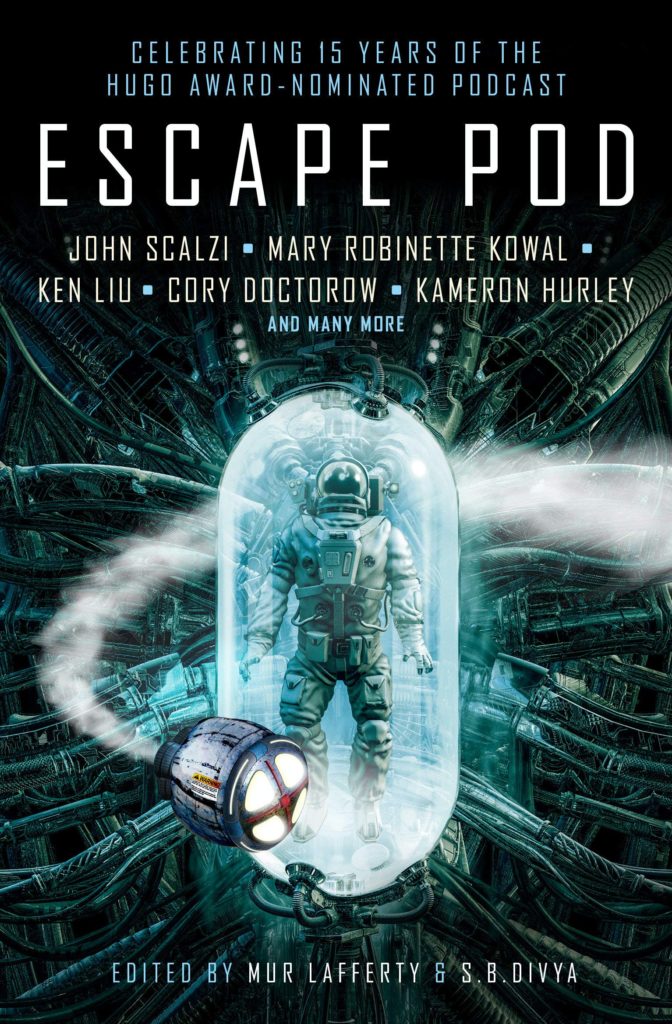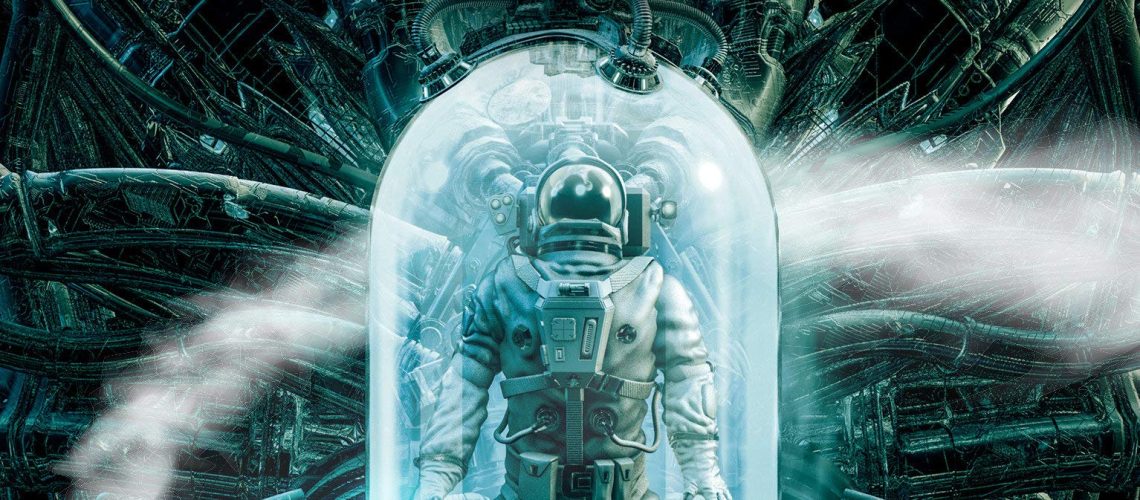The eponymous Escape Pod represents a ‘best-of’ anthology of sorts, celebrating the fifteenth anniversary of the audio short fiction podcast. Edited by Mur Lafferty and S.B. Divya, the book features some of the biggest names in speculative fiction published through the podcast’s history.
While I don’t have interest in listening to stories, I adore them in print form, and this collection from Titan Books offers a diverse selection of high-quality writing. With the current exclusive focus of Skiffy & Fanty on writers/works by the BIPOC community, I’ll highlight here that this collection features superb stories by Maurice Broaddus and N.K. Jemisin.
In what follows, I’ll briefly review the stories in this collection.

- “Citizens of Elsewhen” by Kameron Hurley – A special unit of time-traveling midwives from far in our future arrives in Hispania of the Roman Empire. With a mention of Emperor “Majoram,” readers can pick up immediately that things here aren’t quite right according to our reality. Close, but not right. They are tasked to save future humanity by helping women and babies of the past survive during the risks of childbirth. Memories of failed missions become wiped, and the group is dropped again to retry with only vague AI instructions of what variables to keep or change. Actions of other groups in the timeline rewrite their reality mid-mission. Despite the satisfaction of saving lives, these confusing alterations of time make the team uncertain how their actions align with their assumptions and hopes for the future any more. Are they acting of free will, or are they controlled? But they go on. The story serves as an effective feminist allegory with the paradoxes and headaches that time travel can bring.
- “Report of Dr. Hollowmas on the Incident at Jackrabbit Five” by T. Kingfisher – The I-Witness program from Taxon Interrogation Software interviews a veterinarian living in on a human colony founded by a branch of the Church of the Final Extinction about an incident involving human and goat birthing. Two midwife stories in a row, but this one bursting with dry comedic wit. The incident arises in part due to Jackrabbit Five being founded “on the principles of low-impact colonization and extensive adaptation to local ecological conditions,” which gives the story its speculative angle. But its delight comes from the good doctor interacting with the AI agent of bureaucracy. Imagine Star Trek’s Dr. McCoy dumped into a situation written by Douglas Adams.
- “A Princess of Nigh-Space” by Tim Pratt – A young woman named Tamsin returns to her grandmother’s home where she grew up after learning that her grandmother has been killed. Strange messages left to her on business cards with the names “Bollard and Chicane” in black gothic font add to the mystery. Faced with the danger that claimed her grandmother’s life she learns a surprise about her heritage. There is far too much explanation in this story for me, with Tamsin accepting it too easily and quickly. The story commences with a dark atmosphere, but then turns too rapidly away. I liked the concept, but not the execution.
- “An Advanced Reader’s Picture Book of Comparative Cognition” by Ken Liu – I bought a copy of Liu’s collection The Paper Menagerie, but I still haven’t read it. Reading this makes me want to grab it off the shelf as soon as I can. This is surprising to me in that the structure of this story is not one I’m typically a fan of, and brief passages in the second person simply bug me. Despite this, I adored this story because Liu can compose fantastically powerful narratives from simple, deeply emotionally resonant themes. Here a scientist reads his daughter stories from a “picture book” that explains the cognitive behaviors and capabilities of various alien species. Interspersed with this are things he writes to her about her mother, who has reluctantly left them for an opportunity in space exploration. The “picture book” she has left is full of highly technical language, yet with a fairy-tale tone. It also contains messages for the daughter to help her learn why her mother made the choice she did and to teach her that physical absence is not being completely gone. Beautiful.
- “Tiger Lawyer Gets It Right” by Sarah Gailey – I just finished – and adored – Gailey’s highly anticipated and acclaimed novel The Echo Wife, which I recently reviewed on my site, Reading 1000 Lives. To my recollection, these are the first things I’ve read by them, and I definitely enjoy the wild rides they write. This story is more absurd and both comical and horrifying. Like a fairy tale, it isn’t particularly “believable” even with regards to how characters act. But the story serves to tell a moral and illustrate what it would be like if people really got what they deserved in the courtroom rather than conclusions based on money and power as they typically go.
- “Fourth Nail” by Mur Lafferty – A contribution from one of the editors of the collection and the podcast, this takes place on a station in orbit around the Earth that is populated by clones of very wealthy individuals who both symbolically and literally now live “above” common humanity. A transmission flagged as potential malware arrives, forcing a regular human worker for the facility to make difficult decisions about what to do – decisions that may lead to more than just getting fired. A SF version of The Most Dangerous Game, I found the story somewhat absurd with motivations hard to believe. Yet, I loved the cleverness of the narrator, and the ever-increasing complexity of the plot involving machinations between multiple groups of clones on Earth, the station, and beyond. That’s a lot in a short story, making it seem too short for all the themes and plot details it raises. After reading, I learned that it is related to Lafferty’s novel, Six Wakes, so maybe knowing that can provide a richer experience for this.
- “Alien Animal Encounters” by John Scalzi – Amazingly, this may be the first thing by Scalzi that I’ve read. A humorous short take on what people may view as “alien” or see as confounding aspects of biology or behavior.
- “A Consideration of Trees” by Beth Cato – My go-to favorite sub-genres don’t really include fairy tale fantasies of fae changelings. But put that trope into a science fictional setting and add a dash of ecological themes, and this makes one perfect, memorable story. It makes me wish more contemporary (and science-based) critiques could more routinely make their way into fantasy realms.
- “City of Refuge” by Maurice Broaddus – A devastatingly powerful story that highlights the dystopia present in our real present society in America. Though set in a near future of societal collapse, it only serves to illustrate how even current agencies are already failing a majority of the population. The story is a simple one: an ex-con black man tries to find a job, but has to do this amid the perceptions of others and an antagonistic parole officer. Trying to dredge up any hope for his family and the future of his neighborhood and city, he faces choices regarding refuge, his freedom, and the violence inherent in the system. As noted in the intro to the story by Mur Lafferty, Broaddus wrote this before the BLM movement came to the fore and before “social distancing” took merely a pandemic flavor. Yesterday, I read in the paper of a 9-year-old being pepper sprayed by police and being told “You brought this on yourself.” What will we continue to do personally, and as a society, with this? Broaddus doesn’t give easy answers, but his story makes one feel the demands of these questions deeply.
- “Jaiden’s Weaver” by Mary Robinette Kowal – The warmth of this story feels extra nice after the heaviness of the preceding story by Broaddus. On a colonial ringed-planet, a young girl named Jaiden asks her parents for a pet “teddy bear spider,” a native species that weaves a material they could then sell. Her parents give the usual parent excuses for saying no, but she takes it upon herself to earn and save enough money to get an egg. The resulting animal is born without one of the legs important for proper weaving, but Jaiden loves her anyway. It’s a tale about how value and “uses” do not stick to preconceived notions and expectations. With its short span, Kowal is also able to provide nice SF details about the nature of the alien world. Also, I’m so glad the story was not about the fartycat.
- “The Machine That Would Rewild Humanity” by Tobias Buckell – While en route to the Galapagos, the project lead of the Central Park Human Reintroduction Center receives an automated butterfly messenger that a bombing has occurred in opposition to the planned de-extinction of humans. An interesting reversal of the robot apocalypse plot that interrogates cultural approaches to robots. The best parts of the story detail how the AIs come to decisions and consider global ecological impacts. Simultaneously hilarious and dead serious, Buckell strikes just the right tone.
- “Clockwork Fagin” by Cory Doctorow – A steampunk story about a boy who arrives at Saint Agatha’s Home for the Rehabilitation of Crippled Children and stands up to the abusive warden of the orphanage and leads the other children into brighter futures that utilize, rather than ignore, their skills. Steampunk isn’t my jam, but the elaborate Victorianesque language that Doctorow uses coupled with bits of conversational working-class argot really makes the story captivating to read.
- “Spaceship October” by Greg van Eekhout – A generational ship where the elder generation is kept in luxurious stasis while others suffer without necessities and die. It’s an interesting take on class differences breaking out within a closed SF social environment. Here, the younger and oppressed eventually find the bravery to take action for their own welfare, rejecting the status quo of inequality and the historical reasons for some being more “important” than others. Despite the heavy message of the story in relevance to current national societies, it doesn’t read as heavy-handed. Instead, van Eekhout presents a situation that makes clear the absurdities we accept everyday in a context the reader can easily get behind.
- “Lions and Tigers and Girlfriends” by Tina Connolly – Two teenage girls on a starship headed (and delayed) to a settlement planet decide to stage a play of The Wizard of Oz to pass time and calm growing ill will and possible mutiny in the ship’s population. I adore the concept of this story and the focus away from the “large threat” to the ship. But I’m not partial to its style being written in the form of diary entries by one of the teens. Maybe that’s because I’m in contact with teens so much; it is exhausting. But also: capturing teenage slang – in a speculative future – is really hard to do without it sounding silly and ersatz.
- “Give Me Cornbread or Give Me Death” by N.K. Jemisin – A brilliant short story that mixes dragons with the Biblical plagues and past/current racial dynamics within a near-future dystopic setting. As blacks become targeted more and more for oppression, punishment, or destruction (all while white society in power continues to deny this is what they are doing), some discover ways to tame the weapons used against them to perhaps fight back. A perfect end to the collection, satisfying, yet also still provocative for readers to continue thinking about.
As a final note, the introductions before each story in this collection by the editors are particularly perceptive and informative to read. Excellently curated and arranged, this collection really does provide a nice range of the best that SF has been offering, from a variety of voices and perspectives.







